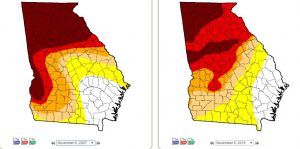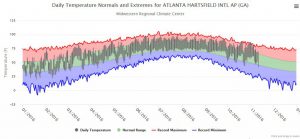At dinner tonight my husband asked me how the current drought compared to 2007. So here’s a little look at the similarities and differences between the two droughts.
In some respects the two droughts look very similar. At this time of year in early November, both of them showed a spatial pattern that covered the northern and western parts of the state. In fact this was near the maximum extent of the drought in 2007. (No doubt Governor Purdue’s prayer for rain had something to do with that.) In 2016 the extent of extreme (D3) drought is actually higher than in 2007, but the extent of exceptional (D4) drought is less.
In the thermographs for Atlanta below from the Midwestern Regional Climate Center’s cli-MATE system, you can compare the daily temperatures between the two years. In 2007 the early part of the summer was actually fairly cool, but in August they had a long stretch of very hot temperatures that seriously impacted water supplies and soil moisture. In some respects the explosion of hot temperatures was a surprise which was probably not expected by water managers and led to dire predictions of Athens, Atlanta and other communities having the potential of running out of water. By comparison in 2016, very few days went over 100 F, but day after day and night after night the temperatures were consistently above normal, which also put a strain on plants and water systems. In 2007 the water levels on Lake Lanier were roughly 16 feet below full pool (I am going from memory here), while this year they are only down about five feet. Is it due to lower daytime temperatures or better water management? Probably some combination of both.
Note that in 2007 the temperatures in October and November were much closer to normal than in 2016, and that cold fronts had begun to move through the area, bring at least temporary relief from the warm conditions. In 2016 the onset of cold frontal passages came almost two weeks later.
In terms of rainfall, in 2007 Atlanta never had more than 20 days of dry weather in a row, which puts tied at 54th for streaks of consecutive days with no measurable rain. By comparison, this year Atlanta has had 26 days in a row with no rainfall so far, and the forecast is for several more days with no rain. For comparison, 29 days in a row with no rain is the 10th longest streak on record for Atlanta. The total rainfall from April through October in 2007 was 18.22 inches and in 2016 was 17.97 inches. Similar, but a little drier in 2016.
So which drought was worse? In terms of rapid onset and severe impacts, I think the edge still goes to 2007, just due to the high temperatures in August and the rapid drop in lake levels across north Georgia. But there is also a case to be made for 2016, particularly in the northwest part of the state, which has seen horrific reductions in rainfall and severe impacts on agriculture, and in some parts of west central Georgia, which is in worse shape now than in 2007 (although they were also hit hard in the drought of 2011-13). This year’s drought is slightly more subtle, but in many cases just as bad as the 2007 drought.
So why is this year’s drought not getting more attention in the media? One reason may be the lower designation by the Drought Monitor, with more D3 and less D4 drought. Personally I think the DM authors are underestimating how bad the drought is here, but that is my own opinion. I know some of you are frustrated at the slow change in the DM because you are seeing how bad the impacts are to agriculture in your counties, and we are trying to help the DM authors see this, but it is a long process. In addition, this year Georgia EPD has also only declared a drought response level 1, which does not require any water conservation other than the usual nighttime-only watering and just mandates water conservation education. This in spite of the fact that at least one county, Haralson, has lost the ability to pull water from their surface water supply and is trucking water into the area. And since Lake Lanier has not dropped as much as in 2007, the immediate threat to the water supply there is less, which makes the media less mindful of the drought situation. Politics may be in play as well, but that’s a column for another day.


